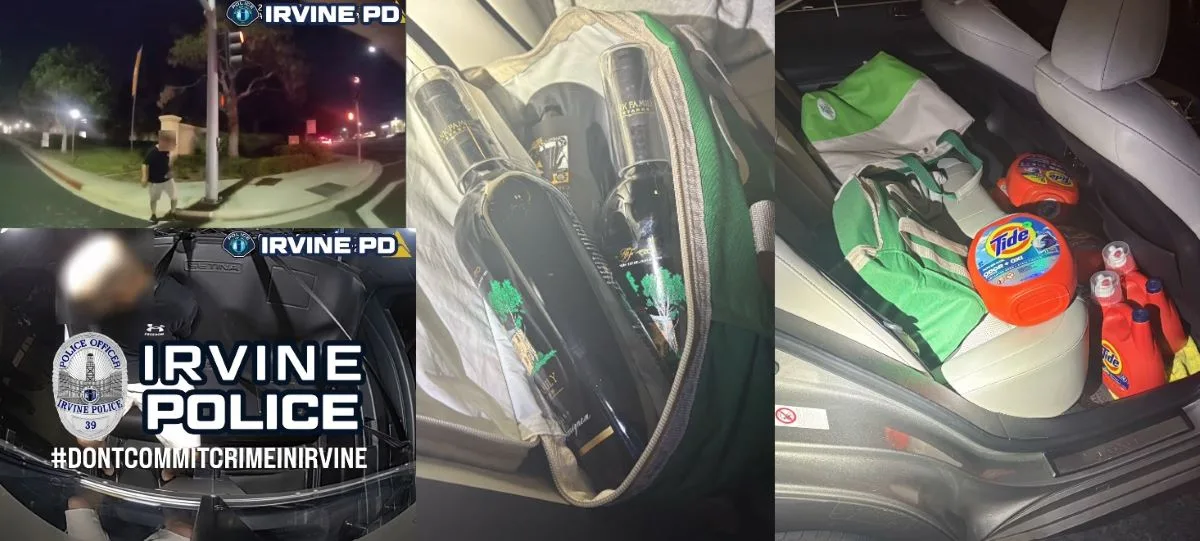On Thursday, police officers were called to Ralph’s for a theft that had just “uncorked,” according to the Irvine Police Department.
Luckily, IPD officers were already in the area and they sniffed out the scheme quickly.
The suspect had already stashed away a bubbly load of detergent and he had boldy returned to the store for more loot. The police officers blocked in the getaway vehicle, but the suspect bolted from the store before his plan could fully ferment.
The IPD Directed Enforcement Team quickly located the suspect, and put a cork in his getaway plan. Inside his vehicle, the officers located numerous bottles of stolen wine.
Cuong Cao, 58, of Long Beach, was arrested for shoplifting and booked into Orange County Jail.
Cao is suspected of stealing wine at other stores in the past. He can now look forward to the California State Prison retirement program.
Based on current California law, here’s a summary of the penalties Cuong Cao could face for shoplifting and repeat theft offenses:
1. Shoplifting Under $950
If the value of the stolen goods is under $950, the offense is typically classified as petty theft, a misdemeanor. Penalties may include:
- Up to 6 months in county jail
- A fine up to $1,000
- Probation or restitution in lieu of jail time, especially for first-time offenders
2. Shoplifting Over $950
If the value exceeds $950 (as it did in this case with multiple bottles of wine), the offense becomes grand theft, which is a “wobbler”:
- Can be charged as either a misdemeanor or a felony
- Misdemeanor grand theft: Up to 1 year in county jail
- Felony grand theft: 16 months, 2 years, or 3 years in county jail
3. Repeat Offender Penalties
Under Penal Code § 666.1, if the suspect has two or more prior theft-related convictions, even petty theft or shoplifting can be charged as a felony, regardless of the value stolen. This law was strengthened by the 2024 Homelessness, Drug Addiction, and Theft Reduction Act, which:
- Allows felony charges for thefts under $950 if the suspect has a qualifying criminal history
- Aims to deter repeat offenders with harsher penalties
4. Diversion Programs
Courts may offer diversion programs or substance abuse treatment instead of incarceration, depending on the circumstances and judicial discretion .
If Cuong Cao has a history of similar offenses, he could be facing felony charges and state prison time. If this is a first or second offense, he may still be eligible for misdemeanor sentencing or alternative programs.
Cuong Cao’s incarceration could temporarily impact his Social Security benefits, but not necessarily eliminate them permanently. Here’s a breakdown of how it works:
1. Social Security Retirement Benefits
- Suspended during incarceration: If someone is convicted of a crime and incarcerated for more than 30 consecutive days, their Social Security retirement benefits are suspended.
- Resumed after release: Benefits can be reinstated the month after release, but the individual must contact the Social Security Administration (SSA) and provide proof of release.
2. Supplemental Security Income (SSI)
- Suspended after 1 full calendar month in jail or prison.
- If the person is incarcerated for less than 12 months, SSI can be reinstated without a new application.
- If incarcerated for 12 months or more, they must reapply for SSI benefits.
3. Disability Benefits (SSDI)
- A felony conviction alone does not disqualify someone from receiving SSDI.
- However, SSDI payments are suspended during incarceration, similar to retirement benefits.
- Benefits can resume after release, assuming the person still meets eligibility requirements.
4. Medicare
- Medicare Part A (hospital insurance) continues during incarceration.
- Medicare Part B (medical insurance) must be paid out-of-pocket to remain active. If premiums aren’t paid, coverage may lapse.
5. Impact on Family Benefits
- If the incarcerated person was receiving benefits that also supported a spouse or child, those dependent benefits may continue, as long as the dependents remain eligible.
So, in Cuong Cao’s case:
- If he was already receiving Social Security (retirement or disability), those payments would pause during incarceration.
- Once released, he could resume benefits by contacting SSA.
- His age (58) does not exempt him from these rules, but it does mean he may already be eligible for early retirement benefits.
